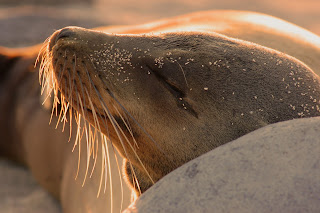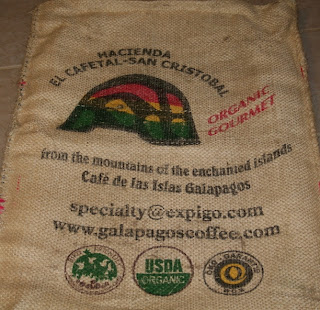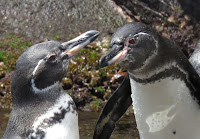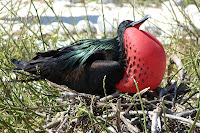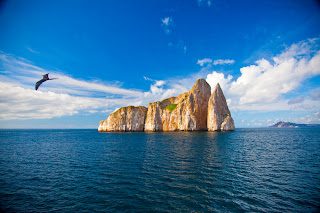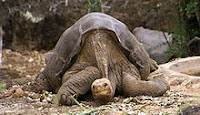Ask any visitor to the Galapagos Islands what they loved about their trip and they are bound to tell you all about our fabulous Blue Footed Boobies. I mention them in many of my posts because we see them on every Island. Typically when I write about those funny,
clown-like and fascinating inhabitants of the Galapagos Islands, I talk about their mating habits and their adorable and irresistible little
chicks. Any one lucky enough to experience their mating dance will have a memory to last a lifetime. I show this ritual in my Espanola Post.
I'm often asked why these birds have blue feet. It's a particularly intriguing question because almost every Galapagos animal or bird species blends into the stark volcanic environment with its pallet a range of brown, beige, sepia, and black, interspersed with green scruffy plant life. How then did they end up with bright blue feet - and electrifying color in contrast to the earthy tones? The answer goes right back to the mating ritual. The males strut around displaying their feet to the females who, in turn, are attracted to that azure color. The bluer the better and more magnetic. The Boobies' feet serve the same purpose as the coloration of so many male birds, like cardinals or frigatebirds.
Sunday, 16 December 2012
Friday, 7 December 2012
Rabida Island
 | |||
| Approaching Rabida from Boat by Mark Putney |
Rabida is located in the center of the Galapagos Islands. It’s a marvelous area for snorkeling as the water teems with fish, marine iguanas and our beloved sea lions. It also offers a special and unique landscape, including the opportunity to walk on a rocky red sand beach.
Labels:
Galapagos,
Rabida island,
Red Sand Beach,
Tourist Sites
Thursday, 6 December 2012
Galapagos Sea Lions - They Are Definitely Not Seals!
 |
| Sea Lion Basking on a Bench in Puerto Baquerizo Moreno |
 |
| Sea Lion Pup |
Labels:
About the Galapagos Islands,
Fur Sea Lion,
Fur Seal,
Sea Lion,
Seal,
Wild Life
Thursday, 15 November 2012
Swimming with Sea Lions
As a guide and naturalist certified by the Galapagos National Park Service and the owner of the Galapagos Eco Lodge on San Cristobal Island in the Galapagos Islands, one of my great pleasures is taking my hotel guests, cruise ship passengers, tourists and visitors snorkeling with the sea lions. The pleasure I get each time I do this is immeasurable to me and I am sure to my guests as well. As a ubiquitous and playful creature of the Galapagos Islands, the sea lions are sure to bring a smile and joy to everyone who encounters them and has the once-in-a lifetime opportunity to frolic in their natural habitat, the luxurious and pristine Pacific Ocean in which the Galapagos Islands are situated.
While every chance to swim with sea lions makes my heart feel good, there is one day I remember particularly well and with great fondness. And that is the day I share with you in this post. Before I do though, take a look at this glorious video taken that day by AquaSurround:
Though every day in the Galapagos Islands is very special, this was a day I was really looking forward to as I was taking my group to swim with the sea lions near Bartolome Island.
Saturday, 3 November 2012
Another Reason to Come to San Cristobal – Our Marvelous Coffee
Until now, it’s been at closely kept secret – or, at least I thought it was a secret. San Cristobal Island grows some of the best coffee beans anywhere in the world. Whether you’re waking up and ready for that first burst of flavor for the day or you’ve had a satisfying meal and want something special with your dessert, our coffee is the answer.
And you can visit San Cristobal's historic coffee plantation to see the old growth trees and taste the coffee yourself. This is a very special adventure and shows the diversity of the Galapagos Islands.
 As I said, I thought it was a secret. Now, I have discovered
that Starbucks – the ubiquitous world wide coffee shop – has discovered this
treasure too. In 2010 and again in 2012, it offered San Cristobal special blend coffee beans in
limited qualities – all of which are gone now.
As I said, I thought it was a secret. Now, I have discovered
that Starbucks – the ubiquitous world wide coffee shop – has discovered this
treasure too. In 2010 and again in 2012, it offered San Cristobal special blend coffee beans in
limited qualities – all of which are gone now. Thursday, 18 October 2012
Isabela Island Visitor Sites Part III - Hiking the Volcanoes
Introduction to Isabela Island
 |
| Map of Isabela from JunglePhotos.com Which reproduced it with permission from Instituto Geografico Militar del Ecuador |
 |
| Landscape on Isabela Hiking Up Volcan Sierra Negra Photograph from CreativeCommons by Michael R. Perry |
- is the largest island in the Galapagos comprising a full 60% of the total land mass in the Galapagos National Park and Reserve.
- is the product of not one, but six integrated separate still-active volcanoes.
- has a magnificent and diverse landscape and sites and attractions inland and around the entire Island.
In this post I will take you on a huge adventure: You will experience the diverse landscape, the enormous beauty and the majesty of the Galapagos Island, Isla Isabela, its creatures and their natural habitat by hiking the stunning volcanoes from which the island was created. Have fun on the journey - but be prepared, not all of this walking will be easy.
Labels:
Cerro Azul,
Darwin,
Ecuador,
Galapagos,
Isabela,
Sierra Negra,
Volcan Alcedo,
Volcan Chico,
Volcan Isabela,
Volcanoes,
Wolf
Thursday, 11 October 2012
Isabela Island Visitor Sites Part II - Sites Visited by Boat
Geography of Isabela Island
 |
| Map of Isabela from JunglePhotos.com Map reproduced with permission from Instituto Geografico Militar del Ecuador |
 |
| Blue Footed Boobies Mating Dance |
- is the largest island in the Galapagos
- comprises a full 60% of the total land mass in the Galapagos National Park and Reserve.
- is the product of not one, but six integrated separate still-active volcanoes.
- has a magnificent and diverse landscape with many individually interesting tour sites and attractions.
If your cruise takes you to the western side of Ecuador's Galapagos Islands, your ship will take you to marvelous inlets, coves, beaches and pools all around Isabela Island. This post will bring you yet another new point of view and opportunity for learning and experiencing, not from the land, as my last post, but from the beautiful, stunning and ever changing Pacific Ocean.
Thursday, 4 October 2012
Isabela Island Visitor Sites Part I - Sites from Puerto Villamil
Basic Geography and Overview of Isabela Island
 |
| Map of Isabela from JunglePhotos.com Map reproduced with permission from Instituto Geografico Militar del Ecuador |
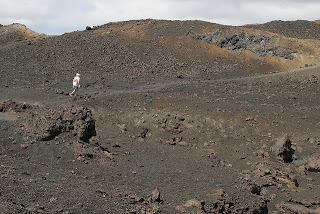 |
| Landscape/Moonscape on Isabela Hiking Up Volcan Sierra Negra Photograph from CreativeCommons by Michael R. Perry |
Isabela is also unique because it grew not from one volcanic eruption, but by the integration of six separate underwater volcanoes. It is the largest land mass in the island system, accounting for 60% of the total land area. Moreover, due to its size and the fact that it arose from the sea as a result of multiple different natural occurrences and eruptions, its landscape is varied and it has many individually interesting tour sites and attractions.
This is the first of three posts I will write about Isabela Island. Here, I focus on the remarkable visitor sites accessible from the main town of Puerto Villamil. Get ready - you are about to experience everything from blue footed boobies to steps carved into a volcanic hillside, from flamingos to a bustling town. Indeed, each visitor to Isabela will experience this enchanted ground from a difference perspective, and, like the Galapagos Islands themselves, Isabela has something to offer everyone.
Sunday, 16 September 2012
Galapagos Island Geography and Geology - Part Three - Ocean Currents
 |
| San Cristobal Island |
Friday, 7 September 2012
Galapagos Island Geography and Geology - Part Two - Galapagos Volcanoes
 |
| Map Showing Galapagos Islands' Volcanoes from ecuador.us |
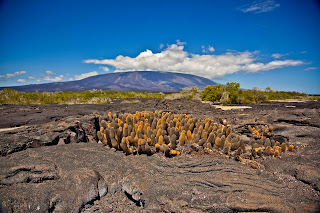 |
| Shield Volcano, Rugged Lava Rock, Lava Cactus Photograph taken by Aqua Surround |
Wednesday, 5 September 2012
Galapagos Island Geography and Geology – Part One – The Tectonic Plates and Hot Spots Created the Volcanic Islands
 |
| The Galapagos Islands The Newest Islands are the Most Westerly The Oldest Islands are the Most Easterly |
This is the first of three posts about the geography and geology of the Galapagos Islands. Each post will take you on a short journey with the explicit intention of providing basic background information about the natural evolution of the Galapagos Islands. These remote islands, unlike anything else on our planet, have a dramatic and ever-changing morphography.
This article - Part One - focuses on the tectonic plates that lie beneath the sea and under the land. For, without the constant movement of the tectonic plates, their crashing into one another, forcing the hot magma to break through the lithosphere, there would be no Galapagos Islands at all. Part Two will discuss the actual formation of the islands from volcanic action that occurs when tectonic plates collide. Each and every one of the Galapagos Islands, their topography, the sheer cliffs that you see and that have become the nesting sites for birds and animal life found no where else on earth, the beautiful outcroppings, SCUBA sites, black sand beaches, crystalline beaches - all is the result of volcanic activity. Finally, in Part Three, I will talk about the Pacific Ocean currents, particularly how the hot and cold currents impact and define the plant, animal, bird and marine life throughout the Galapagos.
Friday, 24 August 2012
Penquins on the Equator
 Our islands are blessed to be the indigenous home of the Galapagos Penguin. This is the only species of penguin that lives above the Equator. They are able to do so because of the cool water temperatures that result from the Cromwell Currents. There are “warm water” Humboldt penguins along the coasts of continental Ecuador, Chile and Peru, but they do not go north of the Equator.
Our islands are blessed to be the indigenous home of the Galapagos Penguin. This is the only species of penguin that lives above the Equator. They are able to do so because of the cool water temperatures that result from the Cromwell Currents. There are “warm water” Humboldt penguins along the coasts of continental Ecuador, Chile and Peru, but they do not go north of the Equator.
Labels:
About the Galapagos Islands,
penquins,
Wild Life
Sunday, 19 August 2012
Genovesa (Tower) Island Visitor Sites
 |
| Genovesa Island - Darwin Bay Photograph from Galapagos National Park Service |
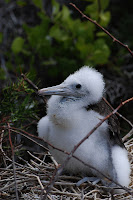 |
| Frigate Bird Chic |
Monday, 13 August 2012
Floreana Island
 |
| Sorting the Mail at the Post Office on Floreana Island |
Post Office Bay and Floreana Post Office
 |
| Evidence of Previous Visitors to the Post Office |
Thursday, 9 August 2012
Fernandina Island - Espinosa Point and Mangle Point
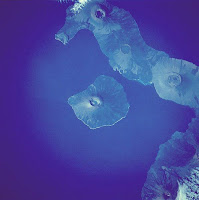 |
| Fernandina on the Left; Isabela on the Right Photograph From WikiCommons |
 |
| Fernandina's Core Erupting in 2009 from Nasa Image |
Labels:
Espinosa Point,
Fernandina,
Mangle Point,
Tourist Sites,
Travel,
Visitor Sites
Bartolome Island - Pinnacle Rock and Beautiful Beaches
 |
| Bartolome Island; Pinnacle Rock Photographed by AquaSurround |
 |
| Steps on Bartolome with Galapagos Hawk Above Photograph by AquaSurround |
Labels:
Bartolome Island,
Pinnacle Rock,
Tourist Sites,
Travel,
Visitor Sites
Wednesday, 8 August 2012
Galapagos Islands - An Overview and Visitor Site Information
Where are the Galapagos Islands? What are The Visitor Highlights?
 |
| Galapagos Islands Map From Wiki |
This post is meant to help you with these and many more questions. Here, I provide you with an overview of visitation to each of the Galapagos Islands, with some of their natural history and geography, along with the visitor site highlights of each Island. In addition, as I continue to blog about the Galapagos Islands, I will add links to detailed information about each site. As always, if you have questions, or you want more detail about anything mentioned in this article, please email me at blueattraction@hotmail.com.
The video below, by Alex Hantke of Aquasurround is one of the most beautiful you will ever see of the magnificent wild life, bird life and marine life you can expect to see when you visit the Galapagos Islands. It is a perfect introduction. Click here to see more of Alex's videos.
The Galapagos Islands are located about 600 miles off of the Pacific Coast of continental Ecuador. Though counted in different ways, they consist generally of 15 primary islands, 3-4 smaller islands and more than 100 rocks and islets.
Sunday, 29 July 2012
San Cristobal Island, Nearby Visitor Sites
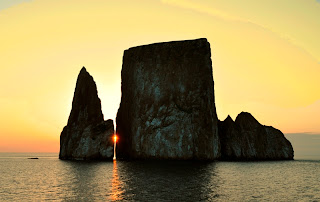 |
| Kicker Rock at Sunset |
While the sites on the island itself are all treasures, the beauty and magic of what lies a short boat ride from the harbor is truly dazzling. The first of these sites, and truly an iconic place in all of the Galapagos Islands, is Kicker Rock, sometimes called Leon Dormido. This is such a spectacular location, breathtaking at any time of day, that it warrants an entire post of its own, Kicker Rock.
Thursday, 26 July 2012
San Cristobal Island Visitor Sites
.JPG) |
| The Hillside and Center of Puerto Baquerizo Moreno on San Cristobal from the Harbor at Sunrise |
The beautiful and versatile San Cristobal Island is one of the most eastern and oldest of the Galapagos Islands. It is moderately-sized, at 195 square miles. But, that land area is filled with some of the most visited and remarkable sites anywhere in the world. This versatility also accounts for the fact that San Cristobal is the second most populated of the Islands; about 8000 people live on San Cristobal. While all of the Galapagos Islands is dedicated to conservancy and maintaining the tenuous ecological balance discovered by Charles Darwin, nowhere is this more true than the Island of San Cristobal itself. It is a forerunner in the quest for renewable energy; at least 60 percent of its energy already is generated by wind and solar power. You will see the wind towers from the harbor and as you drive throughout the island.
Sunday, 22 July 2012
Kicker Rock Near San Cristobal Island, Galapagos Islands
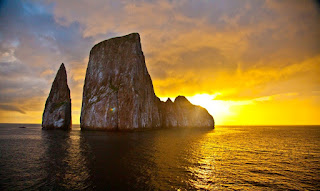 |
| Kicker Rock at Sunset photograph by Aquasurround |
The two inexorable towering monoliths of Kicker Rock are a constant presence within an environment that is otherwise ever-changing and dynamic. Approaching Kicker Rock, you may at first see only one large rock inexplicably rising from the Pacific. As the boat gets closer, you begin to see that there are, in fact, two high peaks and soon you can discern a space between them.
Saturday, 21 July 2012
Espanola Island, Punta Suarez
 |
| Punta Suarez, Espanola Island |
 |
| Baby Albatross |
Espanola Island, Gardner Bay
Espanola Island is the home to several spectacular visitor sites, one of which is the exquisite white sand beach at Gardner Bay. It's a beach perfect for walking and watching the frolicking and resting sea lions, hundreds of which may be seen here at any given time.
To me, this is always a special place. Always, loud guttural barking is a first indication that we have arrived at Espanola Island’s beautiful Gardner Bay. Be prepared for the amazing welcoming committee made of literally hundreds of sea lions lazing on the beach, playing in the surf and soaking up the sun.
Thursday, 12 July 2012
Galapagos Marine and Land Iguanas
 Recently, a tourist was found attempting to smuggle four iguanas out of the Galapagos Islands in a suitcase. This situation was horrible and thankfully the man was stopped and the iguanas are safe. The story created outrage, but it also reminded me that iguanas are a unique and amazing species. While there are still iguanas throughout the Islands, they have become extinct on several islands and are on the endangered species list.
Recently, a tourist was found attempting to smuggle four iguanas out of the Galapagos Islands in a suitcase. This situation was horrible and thankfully the man was stopped and the iguanas are safe. The story created outrage, but it also reminded me that iguanas are a unique and amazing species. While there are still iguanas throughout the Islands, they have become extinct on several islands and are on the endangered species list.At first glimpse, you might find these reptiles to be a bit ugly, even repulsive and scary; you wouldn’t want to face down one of these in a dark alley! But, a second look will probably change your mind. In fact, at second blush, it seems that many of these lizards are smiling. Take a look at this one from Sante Fe Island, for example:
 |
| You Have to Love Him! |
Monday, 9 July 2012
Lonesome George- Part Two
Post Update: Ecuador has honored Lonesome George by listing him as part of the Nation's Cultural Heritage. For a full article see: http://www.mnn.com/earth-matters/animals/stories/ecuador-honors-tortoise-with-national-heritage-nod
On a recent cruise around the Galapagos Islands I was lucky to have as guests a couple from Germany who took professional videos throughout the Islands. They were taking the videos for their company AquaSurround, which specializes in creating music and reflective environments that connect to sophisticated waterbed systems. These videos have been set to music and can be seen and heard on Youtube. They are some of the most beautiful and thoughtful Galapagos videos you will ever see and well worth watching.
Tuesday, 3 July 2012
About Me and Galapagos Eco Friendly
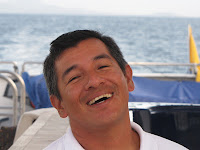 If you love exploration, respect the environment, want to share in the conservation of the paradise we call the Galapagos Islands and yearn to experience first hand the miracles that Charles Darwin brought to the world, then the Galapagos Eco-Lodge is the place to begin your visit to the Galapagos Islands.
If you love exploration, respect the environment, want to share in the conservation of the paradise we call the Galapagos Islands and yearn to experience first hand the miracles that Charles Darwin brought to the world, then the Galapagos Eco-Lodge is the place to begin your visit to the Galapagos Islands. |
| Puerto Baquerizo Moreno, San Cristobal Island The Eco-Lodge is on the hillside overlooking the harbor and Pacific Ocean |
Labels:
About Me,
Conservation,
Ecotourism,
Galapagos Eco Lodge
Monday, 25 June 2012
Lonesome George - Part One
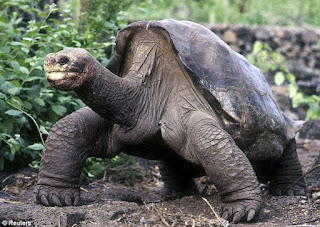 |
| Lonesome George |
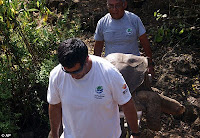 I’ve been to the Charles Darwin Research Station on Santa Cruz Island at least 100 times. Each time George drew me in with his big black/brown sleepy eyes and his long neck. As he dawdled in the leaves, lumbered to his watering hole and lazed in the sun or shade, I wondered about him. Obviously he didn't think in words; neither English nor Spanish popped into his brain. But I observed that he experienced something, interacting with his surroundings, making decisions and providing sustenance for himself. He never seemed phased by our staring at him or studying him. He didn't seem to mind when we became paparazzi and took his picture for posterity.
I’ve been to the Charles Darwin Research Station on Santa Cruz Island at least 100 times. Each time George drew me in with his big black/brown sleepy eyes and his long neck. As he dawdled in the leaves, lumbered to his watering hole and lazed in the sun or shade, I wondered about him. Obviously he didn't think in words; neither English nor Spanish popped into his brain. But I observed that he experienced something, interacting with his surroundings, making decisions and providing sustenance for himself. He never seemed phased by our staring at him or studying him. He didn't seem to mind when we became paparazzi and took his picture for posterity.
Subscribe to:
Posts (Atom)

